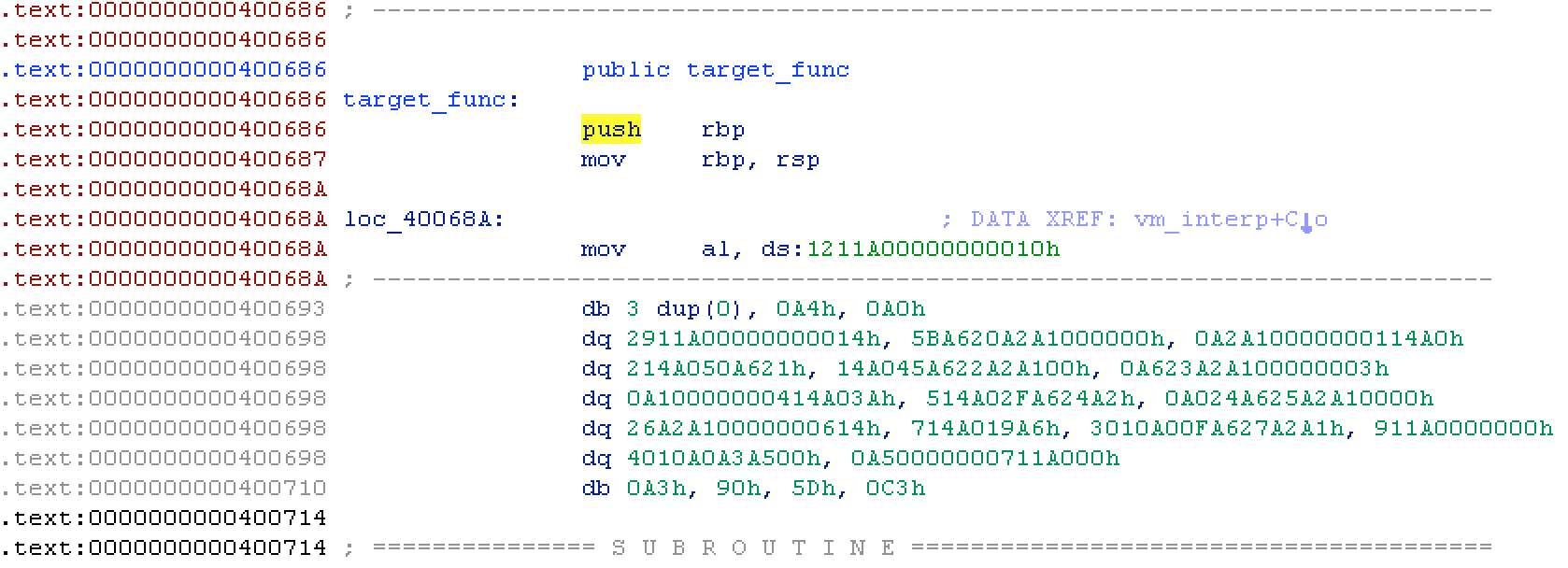1
2
3
4
5
6
7
8
9
10
11
12
13
14
15
16
17
18
19
20
21
22
23
24
25
26
27
28
29
30
31
32
33
34
35
36
37
38
39
40
41
42
43
44
45
46
47
48
49
50
51
52
53
54
55
56
57
58
59
60
61
62
63
64
65
66
67
68
69
70
71
72
73
74
75
76
77
78
79
80
81
82
83
84
85
86
87
88
89
90
91
92
93
94
95
96
97
98
99
100
101
102
103
104
105
106
107
108
109
110
111
112
113
114
115
116
117
118
119
120
121
122
123
124
125
126
127
128
129
130
131
132
133
134
135
136
137
138
139
140
141
142
143
144
145
146
147
148
149
150
151
152
153
154
155
156
157
158
159
160
161
162
163
164
165
166
167
168
169
170
171
172
173
174
175
176
177
178
179
180
181
182
183
184
185
186
187
188
189
190
191
192
193
194
195
196
197
198
199
200
201
202
203
204
205
206
207
208
209
210
211
212
213
214
215
216
217
218
219
220
221
222
223
224
225
226
227
228
229
230
231
232
233
234
| # include "codevm.h"
void target_func()
{
__asm__ __volatile__(".byte 0xa0, 0x10, 0x00, 0x00, 0x00, 0x00, 0xa0, 0x11, 0x12, 0x00, 0x00, 0x00, 0xa4, 0xa0, 0x14, 0x00, 0x00, 0x00, 0x00, 0xa0, 0x11, 0x29, 0x00, 0x00, 0x00, 0xa1, 0xa2, 0x20, 0xa6, 0x5b, 0xa0, 0x14, 0x01, 0x00, 0x00, 0x00, 0xa1, 0xa2, 0x21, 0xa6, 0x50, 0xa0, 0x14, 0x02, 0x00, 0x00, 0x00, 0xa1, 0xa2, 0x22, 0xa6, 0x45, 0xa0, 0x14, 0x03, 0x00, 0x00, 0x00, 0xa1, 0xa2, 0x23, 0xa6, 0x3a, 0xa0, 0x14, 0x04, 0x00, 0x00, 0x00, 0xa1, 0xa2, 0x24, 0xa6, 0x2f, 0xa0, 0x14, 0x05, 0x00, 0x00, 0x00, 0xa1, 0xa2, 0x25, 0xa6, 0x24, 0xa0, 0x14, 0x06, 0x00, 0x00, 0x00, 0xa1, 0xa2, 0x26, 0xa6, 0x19, 0xa0, 0x14, 0x07, 0x00, 0x00, 0x00, 0xa1, 0xa2, 0x27, 0xa6, 0x0f, 0xa0, 0x10, 0x30, 0x00, 0x00, 0x00, 0xa0, 0x11, 0x09, 0x00, 0x00, 0x00, 0xa5, 0xa3, 0xa0, 0x10, 0x40, 0x00, 0x00, 0x00, 0xa0, 0x11, 0x07, 0x00, 0x00, 0x00, 0xa5, 0xa3");
}
void vm_xor(vm_processor *proc)
{
int arg1 = proc->r1;
int arg2 = proc->r2;
proc->r1 = arg1 ^ arg2;
proc->eip += 1;
}
void vm_cmp(vm_processor *proc)
{
int arg1 = proc->r1;
char *arg2 = *(proc->eip + 1) + heap_buf;
if (arg1 == *arg2) {
proc->flag = 1;
} else {
proc->flag = 0;
}
proc->eip += 2;
}
void vm_jnz(vm_processor *proc)
{
unsigned char arg1 = *(proc->eip + 1);
if (proc->flag == 0) {
proc->eip += arg1;
} else {
proc->flag = 0;
}
proc->eip += 2;
}
void vm_ret(vm_processor *proc)
{
}
void vm_read(vm_processor *proc)
{
char *arg2 = heap_buf + proc->r1;
int arg3 = proc->r2;
read(0, arg2, arg3);
proc->eip += 1;
}
void vm_write(vm_processor *proc)
{
char *arg2 = heap_buf + proc->r1;
int arg3 = proc->r2;
write(1, arg2, arg3);
proc->eip += 1;
}
void vm_mov(vm_processor *proc)
{
unsigned char *dest = proc->eip + 1;
int *src = (int *) (proc->eip + 2);
switch (*dest) {
case 0x10:
proc->r1 = *src;
break;
case 0x11:
proc->r2 = *src;
break;
case 0x12:
proc->r3 = *src;
break;
case 0x13:
proc->r4 = *src;
break;
case 0x14:
proc->r1 = *(heap_buf + *src);
break;
}
proc->eip += 6;
}
void exec_opcode(vm_processor *proc)
{
int flag = 0;
int i = 0;
while (!flag && i < OPCODE_NUM) {
if (*proc->eip == proc->op_table[i].opcode) {
flag = 1;
proc->op_table[i].func((void *)proc);
} else {
i++;
}
}
}
void vm_interp(vm_processor *proc)
{
proc->eip = (unsigned char *) target_func + 4;
while (*proc->eip != RET) {
exec_opcode(proc);
}
}
void init_vm_proc(vm_processor *proc)
{
proc->r1 = 0;
proc->r2 = 0;
proc->r3 = 0;
proc->r4 = 0;
proc->flag = 0;
proc->op_table[0].opcode = MOV;
proc->op_table[0].func = (void (*)(void *)) vm_mov;
proc->op_table[1].opcode = XOR;
proc->op_table[1].func = (void (*)(void *)) vm_xor;
proc->op_table[2].opcode = CMP;
proc->op_table[2].func = (void (*)(void *)) vm_cmp;
proc->op_table[3].opcode = SYS_READ;
proc->op_table[3].func = (void (*)(void *)) vm_read;
proc->op_table[4].opcode = SYS_WRITE;
proc->op_table[4].func = (void (*)(void *)) vm_write;
proc->op_table[5].opcode = RET;
proc->op_table[5].func = (void (*)(void *)) vm_ret;
proc->op_table[6].opcode = JNZ;
proc->op_table[6].func = (void (*)(void *)) vm_jnz;
heap_buf = (char *)malloc(HEAP_SIZE_MAX);
memcpy(heap_buf + 0x20, "syclover", 8);
memcpy(heap_buf + 0x30, "success!\n", 9);
memcpy(heap_buf + 0x40, "error!\n", 7);
}
int main()
{
vm_processor proc = {0};
init_vm_proc(&proc);
vm_interp(&proc);
return 0;
}
|

